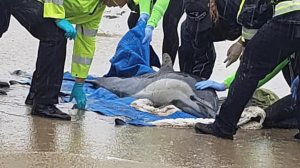A recent influx of beached dolphins along the Orange County coastline has prompted concern from the Pacific Marine Mammal Center, which responded to six such incidents in a recent two-week period this month.
Three cetaceans first washed up along Orange County beaches on Feb. 4, including a male found dead in Huntington Beach. The other two dolphins — also both males — were rescued from Laguna Beach, but had to be humanely euthanized after being examined by animal care and veterinary teams from the center, the organization said in a news release on Monday.

Two deceased female dolphins, both pregnant, were then found along the shore of Corona Del Mar, one on Feb. 10, the other on Feb. 15.
Last Tuesday, the center responded to the final stranding, also at a Corona Del Mar beach, according to the release. It was unclear whether the dolphin was found deceased or euthanized, but that one also died.
Pacific Marine Mammal Care Center officials also received two other reports of cetacean strandings during that span. Of those, one dolphin washed back out into the ocean and another was in a location that was unsafe for rescue teams.
Necropsies were performed on six of the marine mammals, but the results were not immediately released.
The center said it is working with agencies, including NOAA, and academic universities across the country to try and understand the unusual increase of beached dolphins.
“There are a variety of potential reasons as to why these dolphins are stranding. These include, but are not limited to, viral infections, bacterial infections, and toxins,” said Kristen Sakamaki, a veterinarian with the Pacific Marine Mammal Center. “We may not always get a definitive answer, but we consider our research with these dolphins to be a very important piece to the puzzle in providing clues as to what is going on in our nearshore habitats.”
The organization noted that there may have been recent harmful algae blooms along the Southern California coast. The algae blooms can produce domoic acid, which is poisonous for humans, marine mammals and seabirds.
Recent storms could also be another contributing factor, officials said.
The “outbreak” of strandings has the center “very” concerned, according to the release, which noted the organization had only responded to one beached dolphin at this time last year.
“This drastic and unexpected increase in cetaceans has had a significant impact on our Center. With so many incidents concentrated in such a short period of time, this has taken up much of the attention as well as our resources away from our more ‘traditional’ animal care operations focused on seals and sea lions, which coincidentally, we’ve also seen a major increase this year as compared to this same time last year,” Peter Chang, the center’s CEO, said in the release.
Chang continued: “Nonetheless, we are committed to understanding the root of the problem. Although absolutely heart-breaking, these stranding events will provide a tremendous amount of information that will not only contribute to important insights into the lives of dolphins, but also, it will help with the overarching science on the changes that we are seeing in our ocean waters.”
Anyone who encounters a beached dolphin or marine mammal should not try and move the animal, which could actually do more harm than good, according to the organization. Instead, report any sightings to the center immediately by calling 949-494-3050.





